| Frequent and affordable public road transport came
to Darlaston in the early 1880s in the form of steam
trams. The trams began running in Darlaston in 1883
under the terms of the Staffordshire Tramways Order of
1879. They were operated by the South Staffordshire and
Birmingham District Steam Tramways Company, founded in
1882. The company's headquarters and tram depot was in
Corns Street, Darlaston, off Birmingham Street. |
|
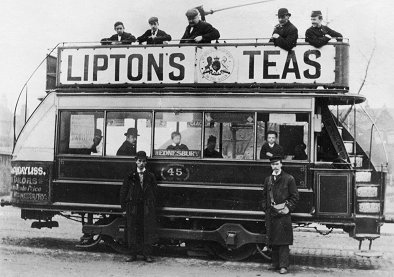
A South Staffordshire Tramways
tram. |
There were 38 steam trams:
|
Fleet number |
Builder |
Year |
| 1 to 2 |
Wilkinson of Wigan |
1883 |
| 3 to 12 |
Beyer, Peacock and Co. |
1883 |
| 13 to 16 |
Thomas Green & Son |
1883 |
| 17 to 21 |
Wilkinson of Wigan |
1883 |
| 22 to 29 |
Beyer, Peacock and Co. |
1884 |
| 30 to 37 |
Thomas Green & Son |
1884 |
| 38 |
Falcon Engine & Car Works |
1885 |
Passenger trailer vehicles:
12 built by the Starbuck Car and Wagon Co.
22 built by the Falcon Engine & Car Works. |
The opening dates for the various sections of the
network, which covered about twenty three miles, were as
follows:
|
Opening date |
|
Route |
| 16th July, 1883 |
|
New Inns Handsworth and
Darlaston, via West Bromwich and Wednesbury. |
| 14th January, 1884 |
|
Carter's Green West Bromwich
to Great Bridge. |
| 21st January, 1884 |
|
Wednesbury to Dudley, via
Tipton. |
| 21st January, 1884 |
|
Darlaston to Moxley. |
| 4th December, 1884 |
|
Wednesbury to Bloxwich, via
Pleck and Walsall. |
| 4th December, 1884 |
|
Darlaston to Pleck. |
| 4th December, 1884 |
|
Extension from Walsall to
Mellish Road. |
| 12th October, 1885 |
|
Great Bridge to Dudley. |
| 21st November, 1885 |
|
Extension at Bloxwich, |
People greatly enjoyed the ease of
travel offered by the first low-priced public transport
system in the area. A large number of passengers was
carried. The local railway passenger services suffered
greatly. The Darlaston branch claimed to have lost
£6,000 in passenger traffic between 1883 and 1886.
Passenger train services were discontinued in 1887.
Ironically the railway delivered the coal for the trams
to Darlaston tram depot. A railway line ran up the side
of the embankment, and into the depot.
Mr. Alfred Dickinson, the General Manager,
who lived in the manager's house next to Darlaston
depot, took out a number of patents relating to trams,
including a road-rail vehicle for use with goods
traffic. It had rail and road wheels, either of which
could be swung into position so that the vehicle could
be used on the tramway, or horse-drawn on conventional
roads. The company was greatly in favour of goods
traffic and ordered several wagons built to Dickinson’s
design. In June 1887 a goods service began across the
system, but not initially in Walsall. Around 150 tons
were carried each week between Smethwick and towns in
the Black Country, mainly Darlaston and Willenhall.
Around 50 tons were carried daily between the Pleck and
Wednesbury. Unfortunately both West Bromwich and
Handsworth councils insisted that the goods traffic had
to stop because it was much noisier than passenger cars.
The company then came to an arrangement with the
Birmingham and Midland Tramways so that the lucrative
goods traffic could continue on a different route.

An impression of a Dickinson
road-rail wagon crossing the Bull Stake.
|
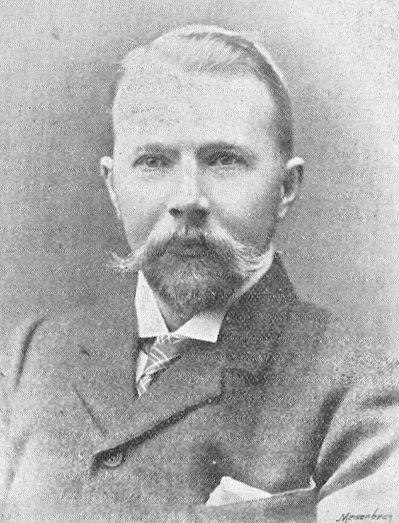
Mr. Alfred Dickinson, J.P. General Manager. |
Mr. Alfred Dickinson, J.P. was
born in Peterborough on February 29th, 1856 and
educated at the Academy in Gorton near Manchester.
Before joining the
Staffordshire Tramways Company in 1883, he spent
seven years at the Manchester, Sheffield and
Lincolnshire Railway which in 1897 became the Great
Central Railway. During his time with the railway
company he worked in most of the departments.
As a Justice of the Peace, he
served on the Wednesbury Borough Bench.
|
On 26th August, 1889 the company
changed its name to the South Staffordshire Tramways
Company, and soon began an electrification scheme. The
installation was carried out entirely by the Electric
Construction Corporation of Wolverhampton. The company’s
chief engineer, Thomas Parker, had previously designed
much of the equipment used for the trams in Blackpool,
the country’s first electrically-powered tramway of any
size.
|
|
The sub-contractor for the cars was the Lancaster
Carriage and Wagon Company. Brown, Marshalls & Company
produced three 150 hp. compound stationary engines for
the generating station, which was built at Darlaston
Road, Pleck, and designed by the Electric Construction
Corporation's chief engineer, Thomas Parker. Coal was
delivered by canal boats on the Walsall Branch of the
canal into a basin alongside the building. The
generating station consisted of an engine room, 59
feet by 45 feet, a boiler house 47 feet by 39 feet, with
an octagonal 120 feet high chimney. The three Lancashire
boilers worked at 120 psi. and were supplied by Messrs.
Musgrave & Son, of Bolton. The three dynamos each
produced 260 amps at 350 volts (91 kW). |
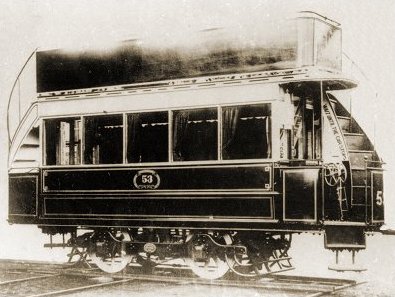
Another of the company's trams. |
|
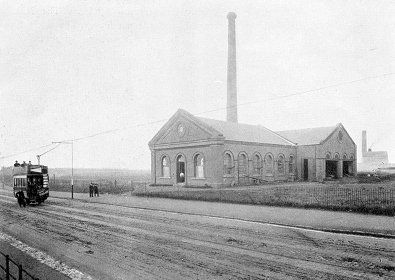
The tramway company's
electricity generating station. |
The traction motors, also designed by Thomas Parker,
were of the Elwell-Parker type. The posts for the
overhead wire were placed at the side of the road, and
the bracket arms carrying the trolley wire stretched out
over the road from 7 to 10 feet, and gave a clear height
of 21 feet.
By a kind of universal joint, the collector was
allowed a variation of several feet, so that the trolley
wire didn't have to be directly over the middle of the
track.
The posts to carry the overhead wire were made by
James Russell & Sons, and John Russell & Company. |
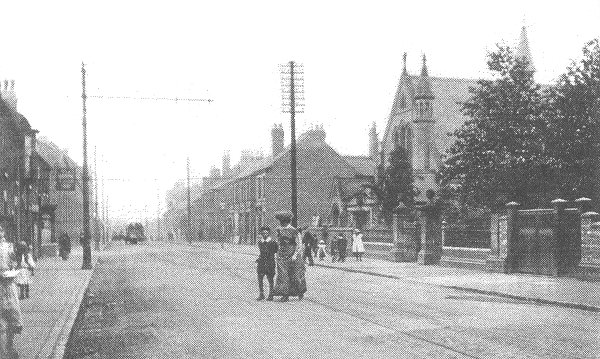
Tram lines and overhead wires at Kings Hill.
From an old postcard.
|
On 1st January, 1893 the
electrified routes from Walsall to Bloxwich, and
Darlaston to Mellish Road via Walsall opened. Other
routes were soon electrified, as was Darlaston tram
depot. The steam trams were gradually phased out.
In the first year of operation the
electric trams carried
1,668,057 passengers. The service was operated
and maintained by the Electric Construction Corporation,
soon to become the Electric
Construction Company.
The trams, in their oak brown and cream livery were a
familiar sight around the Bull Stake, which was often
crowded with tram passengers. |
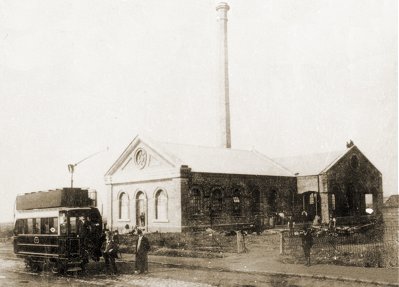
Another view of the
generating station. |
|
South Staffordshire Tramways.
From The Engineer, 18th November, 1892.
Early in the present year
the South Staffordshire Tramway Company entered
into a contract with the Electric Construction
Corporation, of Wolverhampton, for the equipment
of a section of its lines with plant for
electric traction on what is generally known as
the trolley wire system, the lines having
hitherto been worked by steam locomotives. The
plant is now practically completed, and the
inspection by General Hutchinson and Major
Cardew, on behalf of the Board of Trade, took
place on Saturday, November 12th, so that the
electric cars will very shortly come into
service.
The lines over which the electric cars are to
be run extend from the junction of Holyhead Road
and Bridge Street in Wednesbury, through the
centre of the borough of Walsall, to Bloxwich,
with two branch lines, one running from the Pleck to Darlaston, and the other from Walsall
to Mellish Road. The length of streets occupied
by the tramways is just over eight miles, six
miles having a single line with turn-outs, the
other two miles having a double line, making a
total length of track, and therefore of trolley
wire, of over ten miles. The route taken by the
lines is shown on the map - Fig. 5 - which also
indicates the position of the generating station
on the line between the Pleck and Darlaston.
|
|
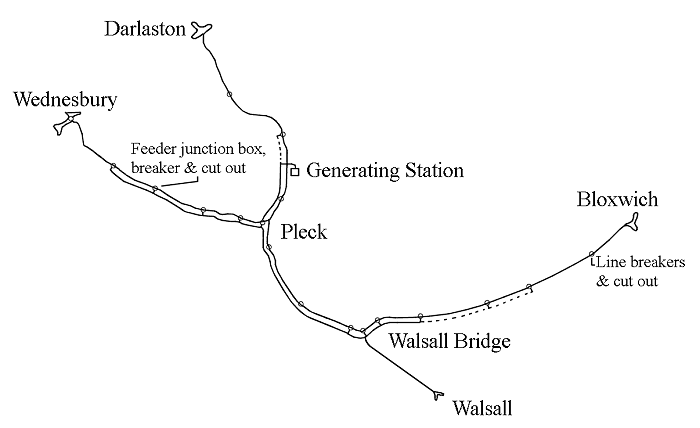
Fig. 5. A map of the tramway. |
|
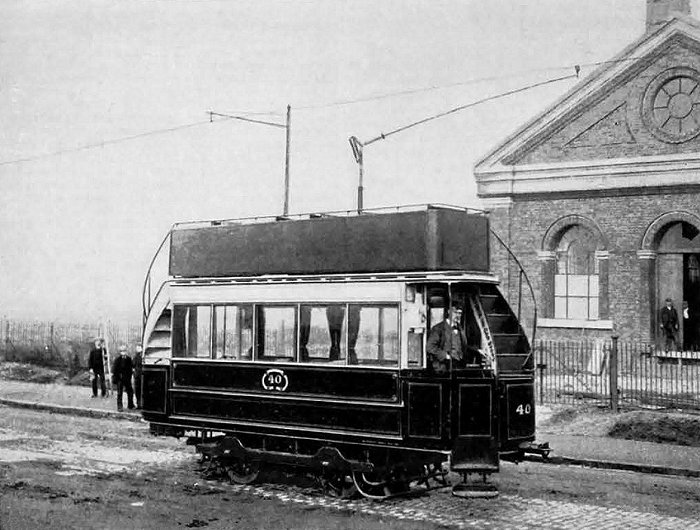
The generating station at Pleck, Walsall. |
|
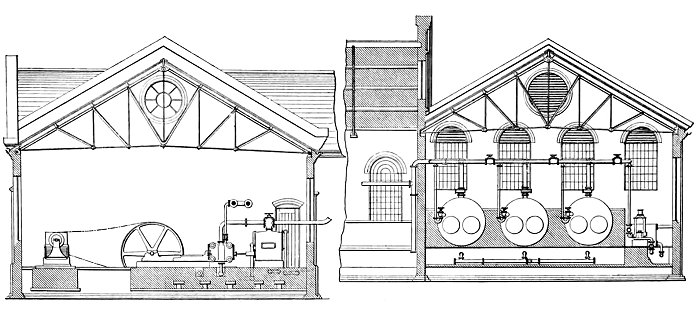
Fig. 6. The generating station. |
|
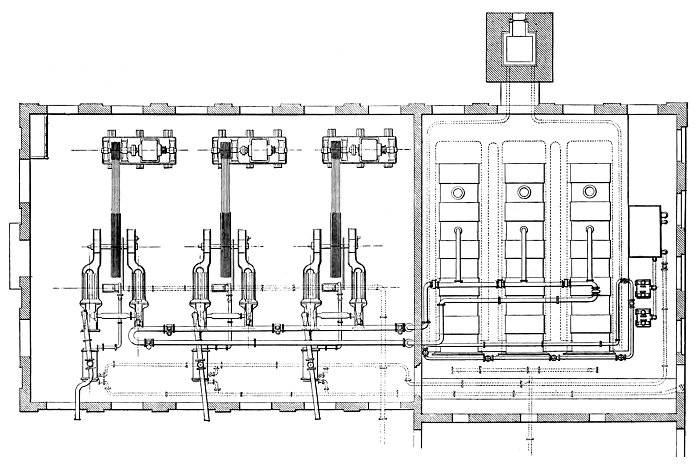
Fig. 7. A plan of the generating station. |
| Arrangements are also provided so that the
engines can be run non-condensing if required.
The dynamos, one of which is driven from each
engine by means of cotton ropes, are of the
usual Elwell-Parker type, and give an output of
260 amperes at 300 volts, when running 400
revolutions per minute, the field magnets being
shunt wound. The driving pulleys are carried
between two bearings, and there is a coupling
between the pulley and armature shafts, so that
the latter can at any time be removed without
taking off the ropes or dismounting the pulley. |
| Each dynamo is connected by cables carried
under the floor to a patent Elwell-Parker
automatic magnetic contact, which also acts as
the main switch for the machine. These
contacts are adjusted so that, in the event of
an excessive current being demanded from the
machines - due to any accident or short circuit
on the lines - the circuit is opened, and any
damage to the machines prevented.
All three machines feed in parallel on to
common omnibus bars, between which and the
feeders taking current out to the line there is
a simple main switch. Ammeters are provided in
each dynamo circuit, and a voltmeter with large
dial indicates the electromotive force across
the omnibus bars.
Multiple contact switches and resistance
coils are connected in the shunt circuits for
regulating the electromotive force.
A section of the switchboard showing the
arrangement for each machine is illustrated in
Fig. 4. |
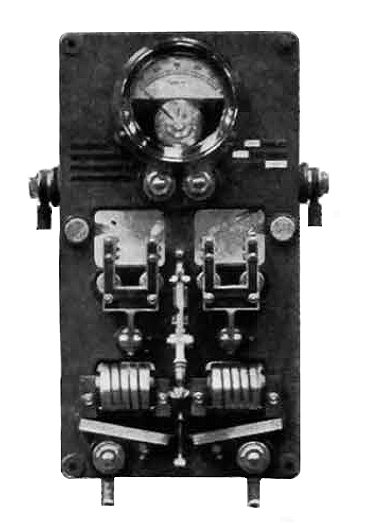
Fig. 4. The switchboard. |
|
From the generating station
the current is supplied to the 0 gauge copper
trolley wire by underground feeders, these being
insulated with vulcanised bitumen, lead
sheathed, and armoured with a double layer of
steel tape, so that they can be laid directly in
the ground without further protection; the
lengths and sections of the feeders are
indicated in the map - Fig. 5.
The return circuit is
completed through the rails and earth. At
distances of approximately half a mile apart
connections are made between the feeders and
trolley wire by means of cables drawn up inside
the posts. Each section of trolley wire is fed
into at both ends, the current passing through
fuses placed in an underground box - Fig. 8 - at
the foot of the feeding posts. These fuse boxes
are made on the diving bell principle, to
prevent any possibility of water accumulating in
them and rising sufficiently high to reach the
connection. The covers are easily drawn up to
allow of examination or insertion of new fuses.
The map - Fig. 5 - shows the position of the
feeding points and fuses. |
|
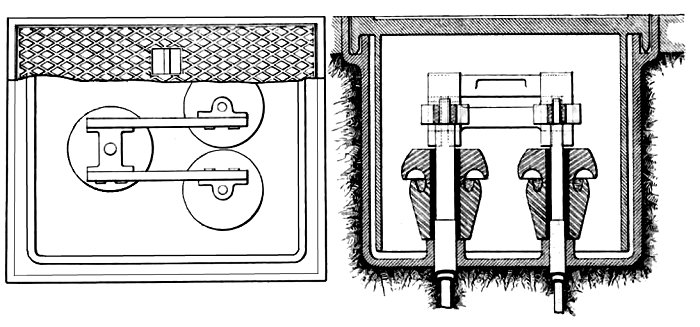
Fig. 8. Underground fuse boxes. |
| The trolley wire is carried at a height of
20ft. from the surface of the streets by poles
along one side of the road only; arms projecting
from the poles - Fig. 7 - carry the insulators
supporting the wire. A special arrangement,
suggested by Mr. Dickinson, the Tramway
Company's engineer, makes it unnecessary that
the trolley wire should be at a regular distance
from the centre of the rails, the collector
being designed so as to allow a variation of
several feet. Where there is a double line of
rails the pole arm carries two insulators and
two trolley wires, one for the up and one for
the down line. Automatic overhead switches are
fixed at the turn-outs, so as to guide the
collector wheel along the right wire. Fourteen
cars made by Messrs. Brown, Marshall, and Co.,
and the Lancaster Wagon Company, are being
supplied for the equipment of the line, each
carrying forty passengers, eighteen inside and
twenty-two outside. The collector is fixed on
one side of the roof of the car, the arrangement
being clearly shown in Fig. 7. |
|
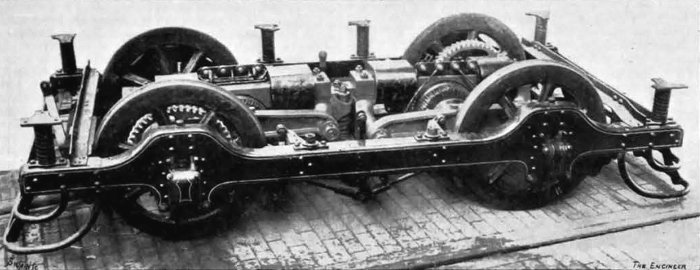
Fig. 2. An under truck with motors. |
|
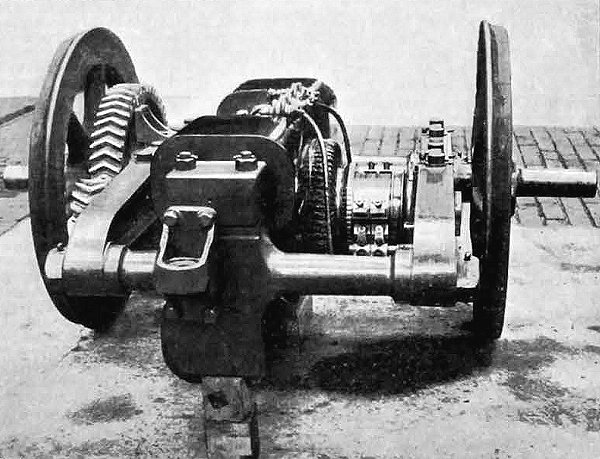
Fig. 3. An Elwell-Parker motor. |
| The under trucks - Fig. 2 - carry two Elwell-Parker
series wound motors - Fig. 3 - each capable of
running continuously with a load of 15
horsepower, the normal speed being 400
revolutions per minute; the armatures are geared
up to the axles by means of cast steel double
helical wheels and pinions, having a ratio of 4
to 1. One motor is considered to be amply
sufficient to take a fully loaded car up the
heaviest gradient of 1 in 28 occurring on the
line. The practice of using two motors on each
car appears to have been brought over from
America, where the lines are not so well laid,
and where, also, they have to contend with snow
and ice throughout the winter. On very few lines
in England do we consider that it will be
necessary to use two motors, although it will be
necessary that the one motor shall be more than
15 horsepower, unless a simple form of gear for
varying the speed with a constant speed of motor
be used. Driving switches are fitted at both
ends of the car, and arranged so that either or
both of the motors can be in use, the regulation
of speed being effected by putting resistance
into the motor circuit. The
whole of the electrical plant has been designed,
manufactured, and installed by the Electric
Construction Corporation, who are also
responsible for the other portion of the plant
supplied to them by various firms as
sub-contractors. The running of the line is also
in the hands of the Electric Construction
Corporation, they having undertaken to work it
at a fixed charge per car mile for a number of
years. Mr. Alfred Dickinson has been appointed
to superintend the working on their behalf. |
|
|
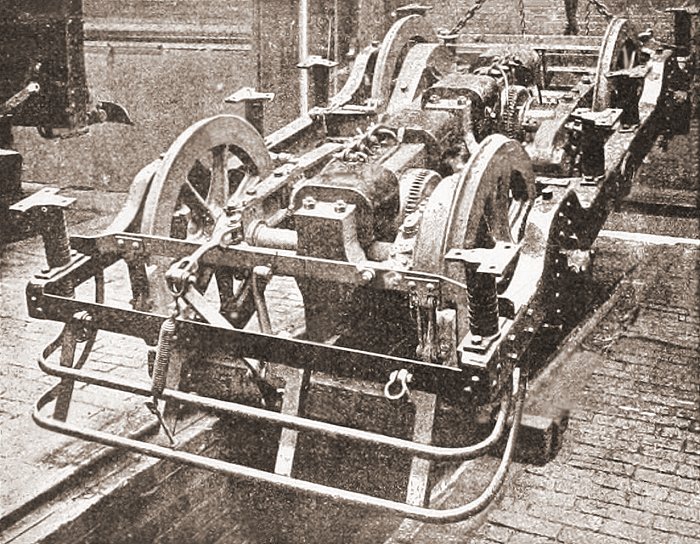
Another photo of an Elwell-Parker
under truck. |
| By 1897 the tram company was behind with its annual
payments to the Electric Construction Company for
running the service. The matter was settled when the
tram company gave a large number of shares to the
Electric Construction Company, giving it a controlling
interest in the tram company.
On 29th July, 1897 the
Electric Construction Company
sold its shares in the tramway company to the British
Electric Traction Company, who now had the controlling
interest in the tram company, and took-over the running
of the services.
On 31st July, 1899 the British Electric Traction Company
formed the South Staffordshire Tramways (Lessee) Company
Limited. The new company took over the operation of the
electrified lines on the South Staffordshire Tramway
network.
Thanks to the frequent and reliable service, people
could quickly travel, and shop in the surrounding towns.
This gave them a much wider choice of commodities, and
changed their shopping habits for ever. |
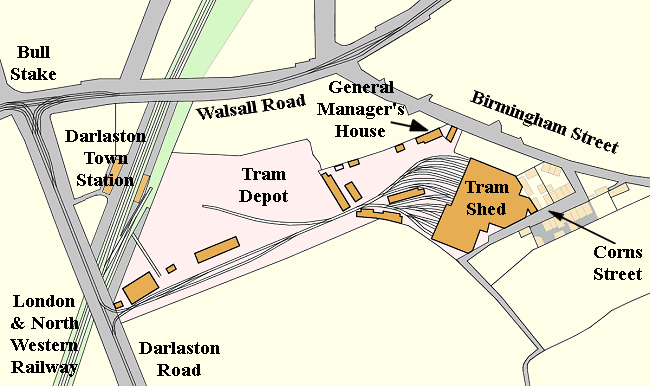
Darlaston Tram Depot.
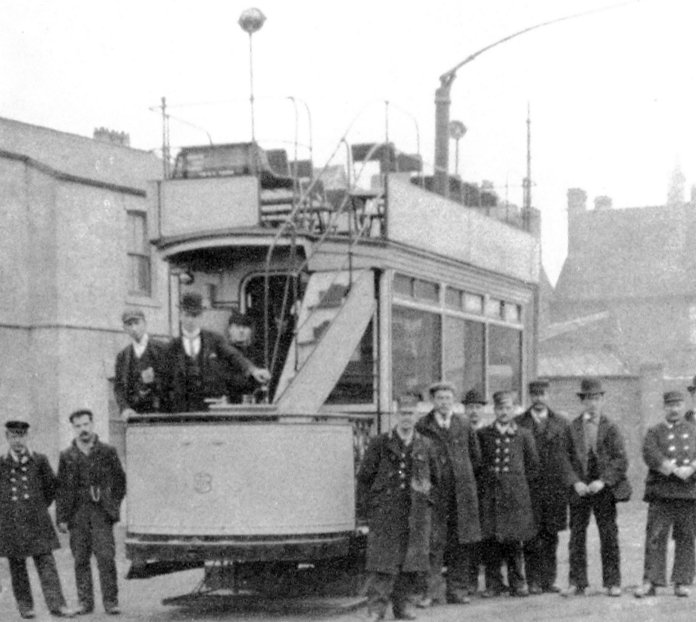
Darlaston Tram Depot yard.
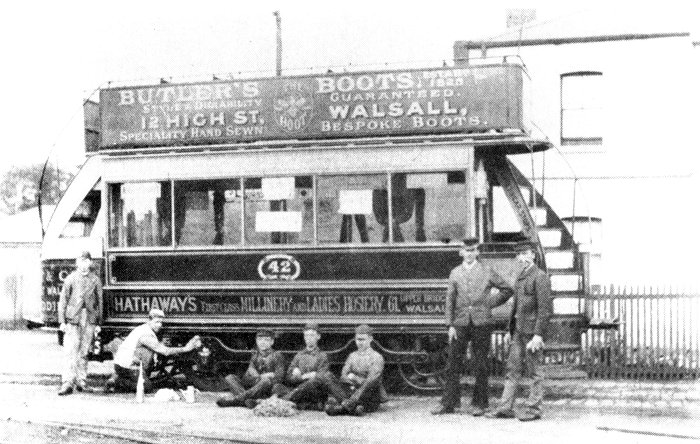
Another Darlaston tram in the depot yard.
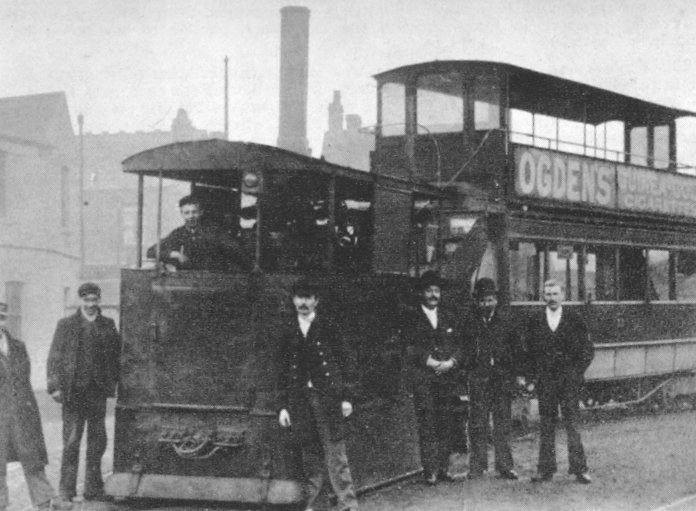
Another view of Darlaston Tram Depot yard.
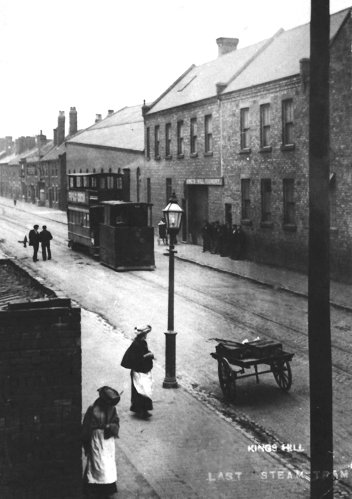 |
A photograph from an old postcard
showing the last steam tram that operated from Darlaston
depot,
on 15th
June, 1904. It's on its
way back to Darlaston from Walsall via the Pleck and
Wednesbury, passing Samuel Platt's King's Hill Foundry.
It took a long time for the
route to be electrified. The line opened to traffic
again in September 1905.
The first electric tram ran
between Wednesbury and Darlaston via King's Hill on
26th
September, 1905. |
|
The route from the Bull Stake to
Moxley ended near the old horse tram depot of the
Wolverhampton Tramways Company, which at the time ran
four-wheeled, open-topped double deckers, drawn by a
pair of horses. There was a tram from Moxley to Bilston
every forty minutes, so passengers from Darlaston to
Bilston had to change at Moxley from an electric tram to
a horse-drawn tram. In 1900 the route was taken over by
the Wolverhampton Tramways Company, and electrified. The
depot at Moxley closed, and a new depot was built at
Mount Pleasant, Bilston.
In 1902 the Wolverhampton District
Electric Tramways Company, part of the British Electric
Traction Company group, secured running rights over the
South Staffs track from the Bull Stake to Moxley, and
began running trams from Stow Heath Lane to the Bull
Stake. People could change at Bilston for Bradley, or
for Dudley, via Sedgley and the Fighting Cocks. On 6th
December, 1902 the Wolverhampton District Electric
Tramways Company began running trams into Church Street
Darlaston from Willenhall, and nine days later extended
the service down King Street to the Bull Stake.
By this time Darlaston had an excellent public
transport system enabling people to easily, and cheaply
travel to most of the towns in the Black Country. Nearly
all of the trams were operated by the British Electric
Traction Company, which acquired leases from local
authorities to run the trams within their area. |
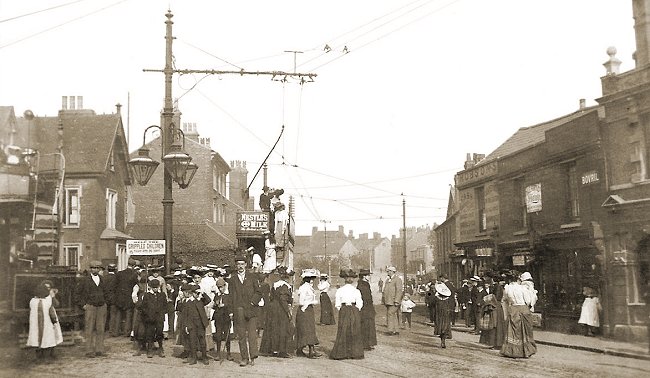
In the early years of the 20th
century, the Bull Stake was a busy place, as people
queued for the trams, and alighted from them on their
arrival in the town. From an old postcard. |
|
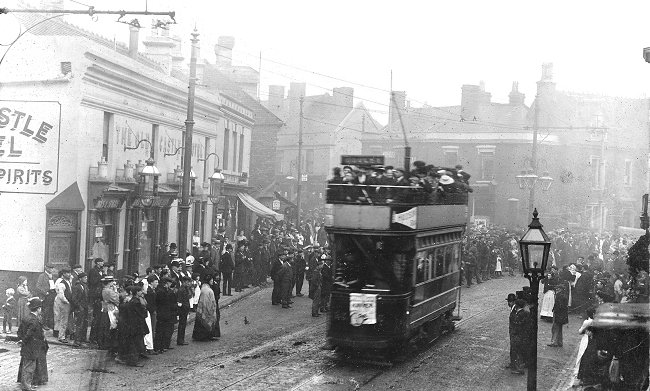
Another view from an old postcard
of the tram queues on the Bull Stake. |
|
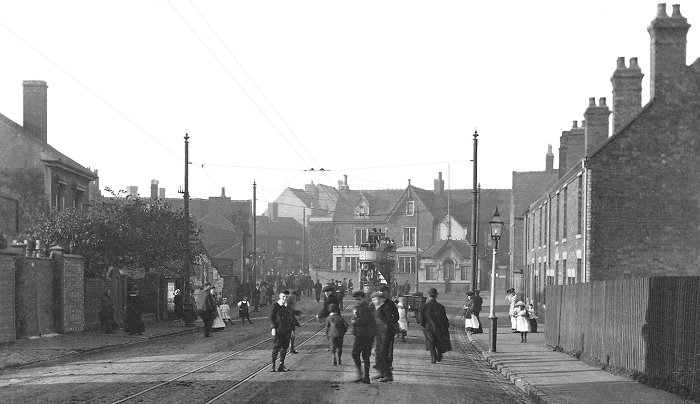
A tram arrives in Darlaston Road
from Wednesbury. |
|
On 1st January, 1904 the Borough of
Walsall began to operate trams on the tramways in
Walsall, after taking them over from their previous
owners. In the early 1930s
Walsall Corporation took over the South Staffordshire
Tramways (Lessee) Company Limited, and replaced the tram
network with motor buses, which resulted in the closure
of Darlaston tram depot. After the closure, the only
trams still running in the Black Country were those
operated by Birmingham Corporation.
The Wolverhampton District Electric
Tramways Company was taken over by Wolverhampton
Corporation under the terms of the Wolverhampton
Corporation Act of 1928. The Corporation purchased the
Bilston depot, and began running trams to the Bull Stake
on 1st September, 1928. In 1929 the Corporation began
replacing the trams with trolley buses. The first
trolley bus ran to the Bull Stake on 27th January, 1930. |
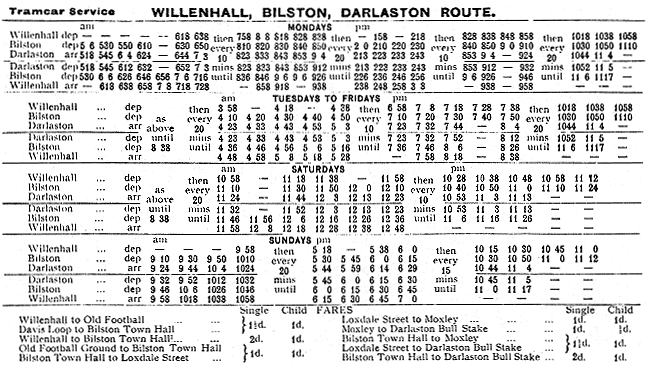
From Wolverhampton Corporation's 1928
timetable.
|
From the
Walsall Observer, 6th June, 1931. |
|

A Walsall tram at the
Bull Stake in about 1910. |
The trolley buses dropped
passengers off by Pinfold Street Wesleyan Chapel, turned
round at the Bull Stake, and stopped outside Len
Mitchell’s shop before returning to Wolverhampton.
The
frequent and reliable service was very popular. The last
trolley bus ran from the Bull Stake on 8th August, 1965.
|
|
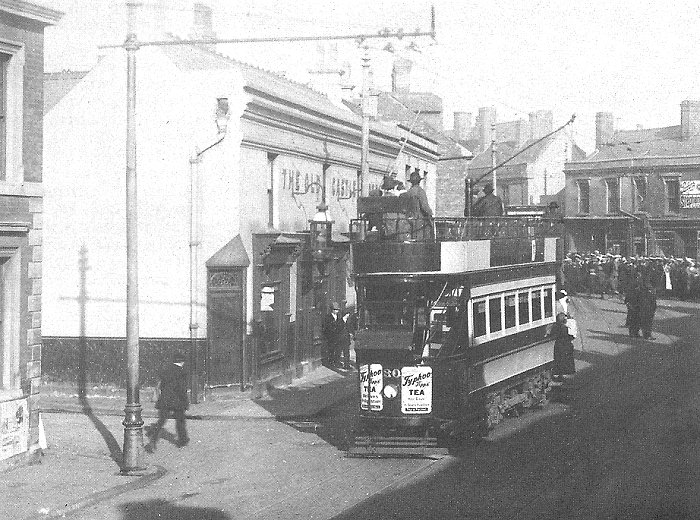
A Wolverhampton & District
Electric Tramways tram, number 30, arriving from
Bilston in the early 1920s. |
|
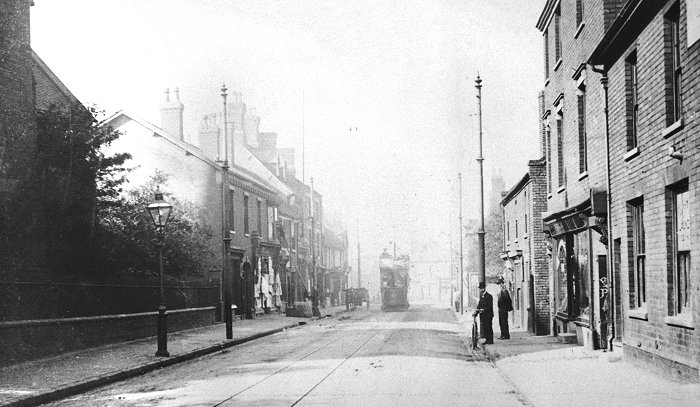
A tram travels along Church
Street on its way to Willenhall. |
|
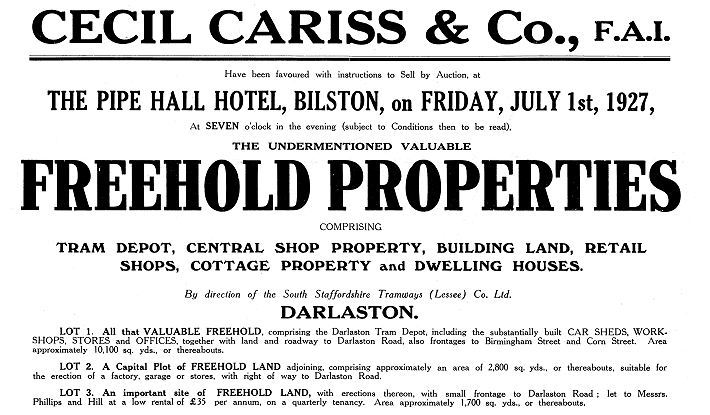
The sales literature for the tram
depot. |
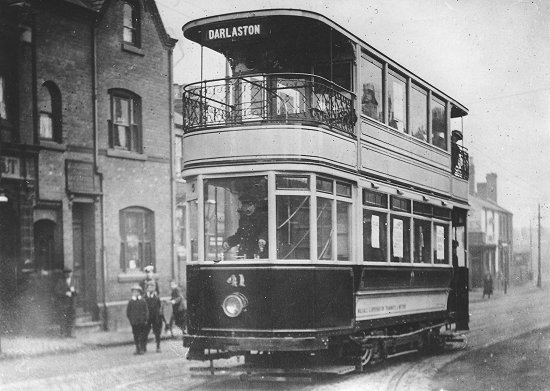
Walsall Corporation Tramways
tram number 41 turns into Bescot Road, from
Wednesbury Road, on its way to Darlaston via
Wednesbury. The building on the left, the Brown Lion
pub is still much as it was in 1930 when the
photograph was taken. |
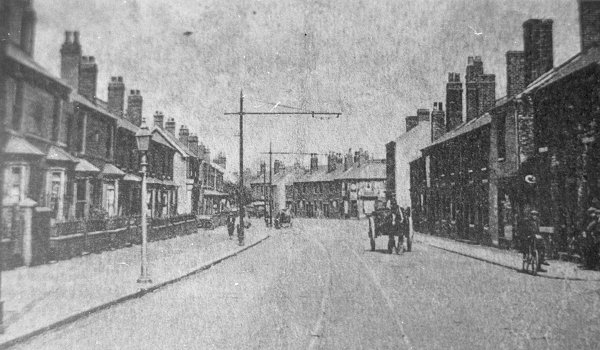
This poor quality photograph
taken in Walsall Road shows the single tram lines
that were in use at the time. Passing places were
used to allow two-way working. |
|
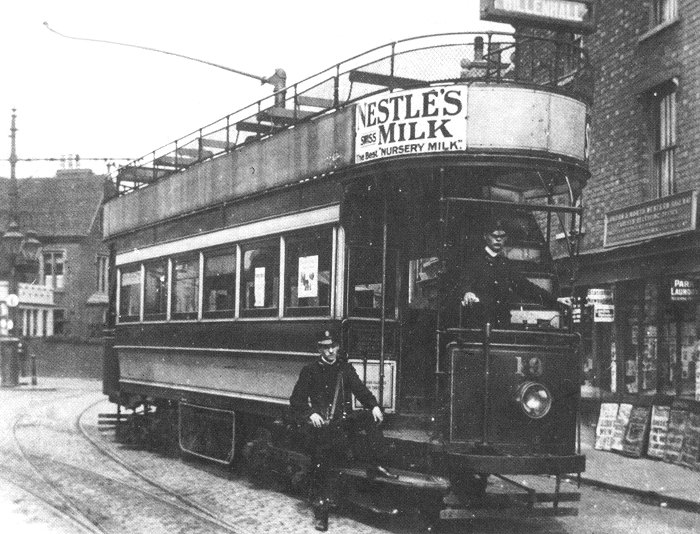
A tram on the Willenhall
to Darlaston and Bilston route, at the Darlaston
terminus in Pinfold Street. |
|
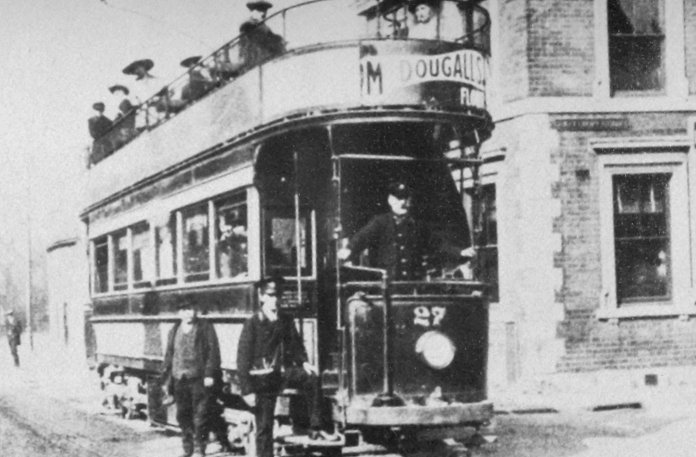
A tram in Pinfold
Street, on the corner of Great Croft Street. |
|
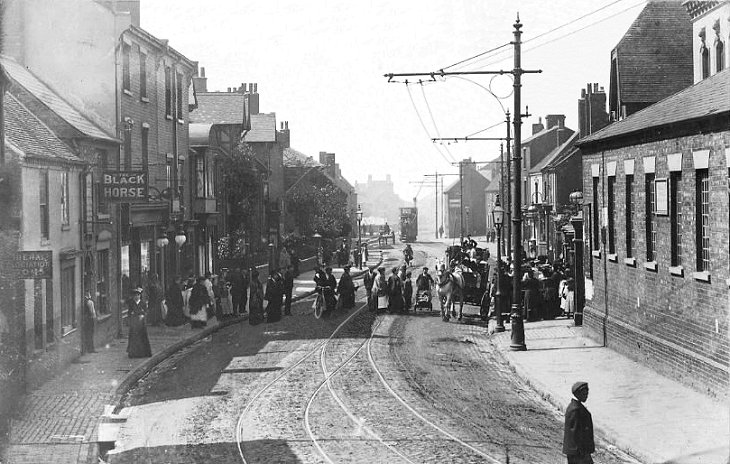
Waiting for a tram
in Pinfold Street. |
 |
 |
 |
Return to
Darlaston Pubs |
Return to
Contents |
Proceed to the
20th Century |
|